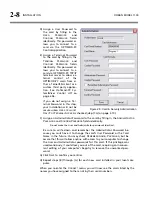
1-30
INTRODUCTION
ORBAN MODEL 1100
increase above the nominal threshold of limiting. This increase is typically less
than 0.5dB.
•
Second is additional processing, such as equalization. Equalization that applies
boosts at certain frequencies is very likely to add peak level and thus cause clip-
ping. However, equalization that attenuates certain frequencies can also cause
overshoots because of added phase shifts. So be wary of any equalization and
allow headroom to accommodate it.
•
Third is headroom in lossy data compression systems. A well-designed percep-
tual encoder will accept samples up to 0 dBfs and will have internal headroom
sufficient to avoid clipping. However, there is no guarantee that
receiver
manu-
facturers or
decoder
providers will implement perceptual decoders with suffi-
cient headroom to avoid clipping overshoots. Such overshoots are the inevitable
side effect of increasing the quantization noise in the channel, and can be as
large as 3-4dB. Most perceptual encoder algorithms are designed to have unity
gain from input to output. So if peak levels at the input frequently come up to
0dBfs, peak levels at the output will frequently exceed 0dBfs (and will be
clipped) unless the decoder algorithm is adjusted to be less than unity gain.
Canny engineers will therefore familiarize themselves with the performance of
real-world receivers and will reduce the peak modulation of the transmissions if
it turns out that most receivers are clipping due to perceptual encoding over-
shoots. Our experience to date indicates that allowing 3dB headroom should
prevent audible overshoot-induced clipping in low bite-rate systems (e.g., 32
kbps streams), while 2dB is adequate for 128kbps and above. While some clip-
ping may still occur, it will have a very low duty cycle and will almost certainty
be inaudible.
Monitoring on Loudspeakers and Headphones
In live operations, highly processed audio often causes a problem with
the DJ or
presenter’s headphones.
When its built-in inputs and outputs are used, the delay
through OPTIMOD-PC can be as much as 25ms (or more, if the installer purposely
adds frame-makeup delay). This delay, although not usually audible as a distinct
echo, can cause bone conduction comb filtering of the DJ/presenter’s voice in his/her
ears. This is almost always very uncomfortable to them.
Delays through the computer’s internal WAVE audio can be much larger.
These delays are difficult or impossible for the user to control because
they are functions of the computer’s operating system. To minimize de-
lay, use OPTIMOD-PC’s hardware inputs and outputs.
OPTIMOD-PC’s processing has a second output after the multiband compressor but
before the look-ahead peak limiter, which is where the majority of the delay occurs.
This output feeds one of the inputs to the output routing switcher in the Orban I/O
Mixer application.
Содержание OPTIMOD-PC 1100
Страница 1: ...Operating Manual OPTIMOD PC 1100 Digital Audio Processor on a PCI Sound Card Software Version 2 0...
Страница 4: ......
Страница 5: ...Operating Manual OPTIMOD PC 1100 Digital Audio Processor on a PCI Sound Card Software Version 2 0...
Страница 18: ......
Страница 54: ......
















































